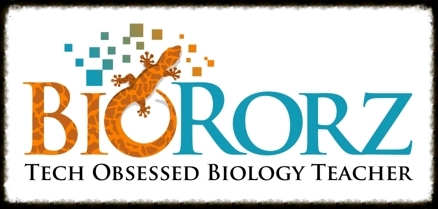Collaboration For the Win! Bringing "Big Kid" Science to KG
Kindergarten students figuring out the microscope!
Guest co-writer: Tiffany Hill @tifftado
The time has come to close the loop on the collaborative project between my 11th grade IB biology class and Tiffany Hill's kindergarten class. Back in February, Tiffany and I discovered that my 11th grade biology students and her kindergarten students were studying similar topics. My students were learning about cellular respiration in yeast and her students were planning on baking bread as a culminating activity for their unit on wheat (see video below). Talk about coincidence! We decided that it would be great if my students could create a video to teach her kids about how yeast contributed to the rising of bread through a couple of science demos, and then ask them for help on a science experiment that they could engage in while baking their bread. Incidentally, this also tied in with their upcoming measurement and visualizing data units in KG.
In a previous post, Going Back to Kindergarten, I talked about this project from our end in the "big school". Today, Tiffany sent me her class's video response to our project. I happened to get the e-mail right before my 11th grade biology class today, so without previewing it, I shared all of this five year old yummy goodness with my class. They LOVED it...too much...in fact they all whined for about 10 minutes about how they want to go back to kindergarten. To be completely honest, so do I, and not just because they get donuts for snack time! The video below explains our project from KG's perspective.
My favorite quotes:
"Dump it in there, BOYFRIEND" (I don't think that would fly with my 11th graders)
"Are we gonna draw it on the paper because that's what real scienstists do...(in case you didn't hear me) REAL SCIENSTISTS DO THAT!"
Collaborating with Rory on this project was such an awesome learning experience for my students and myself. It was excellent timing that our classes happened to be doing units with such easy connections. Thank goodness for WWW (Women, Wine, and Wednesdays...not necessarily in that order) for allowing us to make these connections! Having the big kids ask KG students for help made them feel really special and it set a natural purpose for their inquiry. This project was the perfect fit not only to our PYP Unit of Inquiry, "How we Organize Ourselves", but also to our math units of measurement and data collection. When I reflect upon the way I taught this exact same sequence of explorations last year and compare it to this year I am over the moon at how this one day allowed for so much exposure and knowledge growth. The integration of technology was a huge plus as well. I am very excited to repeat this project next year and I look forward to inviting my colleagues to be on board!
- Tiffany Hill -
This project was so successful on both fronts that we are definitely planning to expand it to include both sections of biology and all of the KG next year. Thanks to technology, even if our units don't align in the future, my students can prepare the video in advance so that it will be ready for kindergarten when they need it! Win - Win! Tiffany, if you are reading this, next year, we expect to at least get some bread and maybe some chocolate donuts out of this for all of our hard work!
One of these kids is not so interested in putting the bread in the cupboard to rise. Yummmmmm donuts!

















